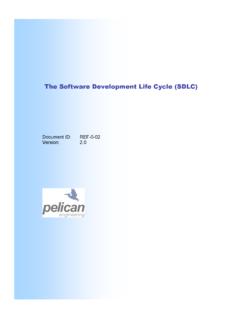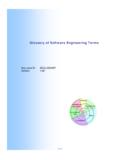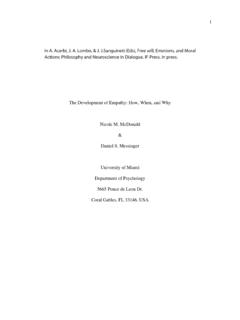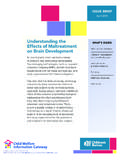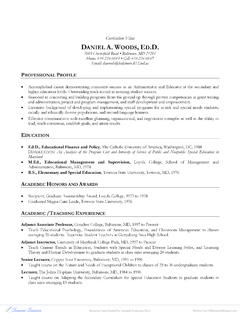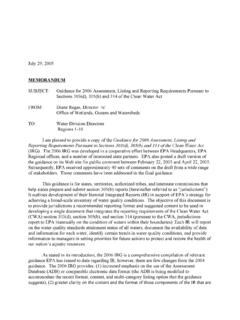Transcription of Measuring The Impact Of Training
1 RICHARD CHANG ASSOCIATES, INC. 1 Measuring THE Impact OF Training Measuring THE Impact OF Training DEMONSTRATE MEASURABLE RESULTS AND RETURN ON INVESTMENT Why do some Training & Development functions have increasing influence and Impact , while others constantly battle for more resources, time, and management attention? Have you ever heard some manager or executive say .. Send my people to Training not me! It s a waste of time, it costs too much, and it doesn t work! I need my people to do some real work, not sit around and talk about some theoretical ideas that they can t apply on the job! The answer to both of these issues frequently has to do with the way that Training & Development is approached. Successful Training & Development functions typically use an Impact - or results-based approach, rather than an activity-based approach.
2 Measurement is a key driver in establishing a successful, results-based approach. Strategic use of measurement and evaluation techniques can improve the value, quality, and Impact of your effort; demonstrate the need for the effort; and increase management s support, involvement, and resource allocation to the Training & Development function or system. Learning Objectives Upon completion of this session, you will be able to: 1. Demonstrate the business-focused alignment and linkage between Training & Development efforts and your organization s overall performance 2. Develop evaluation tools/processes that demonstrate the employee response and performance improvement from the Training (Participant RESPONSE and On-The-Job ACTION) 3. Develop evaluation tools/processes that demonstrate the business-focused RESULTS and organizational Impact of the Training Included with this Participant Workbook is the following guidebook, published by Richard Chang Associates, Inc.
3 Measuring The Impact Of Training RICHARD CHANG ASSOCIATES, INC. 2 Measuring THE Impact OF Training Measuring The Impact Of Training (cont.) Agenda Developing An Aligned Purpose What To Measure In Training & Development Efforts Selecting RESPONSE Measures Selecting ACTION Measures Selecting RESULTS Measures Selecting Impact Measures Calculating Impact RICHARD CHANG ASSOCIATES, INC. 6 Measuring THE Impact OF Training WHAT TO MEASURE IN Training & DEVELOPMENT EFFORTS QUESTIONS TO ASK MEASUREMENT OUTCOME 1. What Impact should this Training & Development effort have on the organization? Organizational Impact 2. What business-focused results should be attained? Business-Focused RESULTS 3. What on-the-job action should take place as a result of the Training & Development effort?
4 On-The-Job ACTION 4. What does the participant response to and from the Training & Development effort need to be? Program RESPONSE (Did they like it? Did they learn?) What you measure depends on (1) your organization s needs and (2) the size, breadth, and depth of a given Training & Development effort. You will need to look at each Training & Development effort individually, and decide which measurement(s) will bring the most value. Levels Of Measurement In 1959, Donald L. Kirkpatrick revolutionized the Training & Development industry when he defined four levels of measurement (reaction, learning, behavior, and results). Using Kirkpatrick s widely-accepted framework, RCA has developed a practical approach to demonstrate the organizational Impact of your Training & Development efforts.
5 KIRKPATRICK LEVELS RCA S APPROACH 1. Evaluating Reaction 2. Evaluating Learning 3. Evaluating Behavior 4. Evaluating Results 5. < > Program RESPONSE On-The-Job ACTION Business-focused RESULTS Organizational Impact Answering these questions keeps measurements value-added and aligned with strategic business goals. If you do not know what is important to measure, you may not be Measuring the right things! RICHARD CHANG ASSOCIATES, INC. 7 Measuring THE Impact OF Training SELECTING RESPONSE MEASURES IMPACTRESPONSERESULTSACTION RESPONSE evaluation enables you to: Get feedback from the participants regarding the program s quality and helpfulness (response TO the program). Find out if participants have learned what the Training attempted to convey (response FROM the program).
6 Build a foundation for other Training measurements. As you work through this step of the measurement process, consider the following: 1. Allow time for evaluation. 2. Create a simple, short evaluation. 3. Don t skew results. 4. Include an evaluation form for the trainer/facilitator/coach. MANAGEMENT TEAM RESPONSE IDEAS Remember Alfonso ..? Have participants rate their response to the program through a Session Questionnaire. For example, how well did the participants like .. what was their reaction to .. Program Materials Depth Exercises Trainer Knowledge Motivation Process Pace Schedule Have participants rate their response from the program (their new knowledge) through self-report (session questionnaires, role-play, demonstration, etc.)
7 For example, during Management Training , how well did participants learn to: Plan Employee Performance Coach and Develop Others Focus on Customer Needs Foster Teamwork Manage for Quality Value Diversity Evaluate Employee Results Demonstrate Adaptability Measuring The Impact Of Training Pages 26 29 Measuring The Impact Of Training Pages 30 35 RICHARD CHANG ASSOCIATES, INC. 17 Measuring THE Impact OF Training Selecting ACTION Measures (cont.) MANAGEMENT TEAM ACTION IDEAS Remember Alfonso .. ? Within one week of Management Training (and continuing on thereafter), participants will be: Completing and using Feedback Planners in 80% of the coaching of employees Tracking department efficiency using the described process management system Applying motivational tools real time Etc.
8 Within 90 days of Management Training , participants will have: Performance Plans in place for all direct reports Orchestrated at least one Voice of the Customer Survey Initiated a Diversity Ranking Scale Etc. Alfonso s Survey Recently, a member of your team completed Management Training . Please evaluate this person s use of the following tools on the job. Use Competency Topic Feedback Planner Process Management System Motivational Techniques Performance Plans Voice Of The Customer Surveys Personal Profile System (DiSC ) to guide in flexing styles to build team relationships CPI Processes Diversity Communication Planner Measuring The Impact Of Training Page 43 Rating Scale of 1 to 5 1 = Little to no use/ Little to no competency 5 = High use/High degree of competency RICHARD CHANG ASSOCIATES, INC.
9 26 Measuring THE Impact OF Training Selecting RESULTS Measures (cont.) Results Example New Employee Orientation MEASUREMENT CATEGORY: TIME BASELINE MEASURE PROJECTED TARGET ACTUAL RESULT (AFTER Training AND DEVELOPMENT EFFORT) 1. Average New Employee Orientation time (from general company introduction through basic, on-the-job Training ) 2. The time required for new employees to be performing at 90 percent efficiency 3. Average time spent by Benefits Specialists answering basic policy questions after New Employee Orientation 30 working days 60 days 500 hours per year 10 days 30 days 100 hours 15 days 25 days 75 hours MEASUREMENT CATEGORY: OUTPUT BASELINE TARGET ACTUAL 4. Number of new employees going through New Employee Orientation per month 5.
10 Number of partnerships established to support New Employee Orientation process 6. New Employee Orientation feedback sessions per year 25 0 0 50 10 12 45 9 4 MEASUREMENT CATEGORY: QUALITY BASELINE TARGET ACTUAL 7. Customer satisfaction with New Employee Orientation as reported back by new employees 8. Customer satisfaction with New Employee Orientation as reported back through Business Unit Management 9. The degree to which the New Employee Orientation process addresses basic benefit questions as validated by the Benefits Specialist Group 5 out of 10 3 out of 10 20% out of 10 9 out of 10 90% 9 out of 10 9 out of 10 80% MEASUREMENT CATEGORY: COST BASELINE TARGET ACTUAL 10. New Employee Orientation cost per new employee 11.

